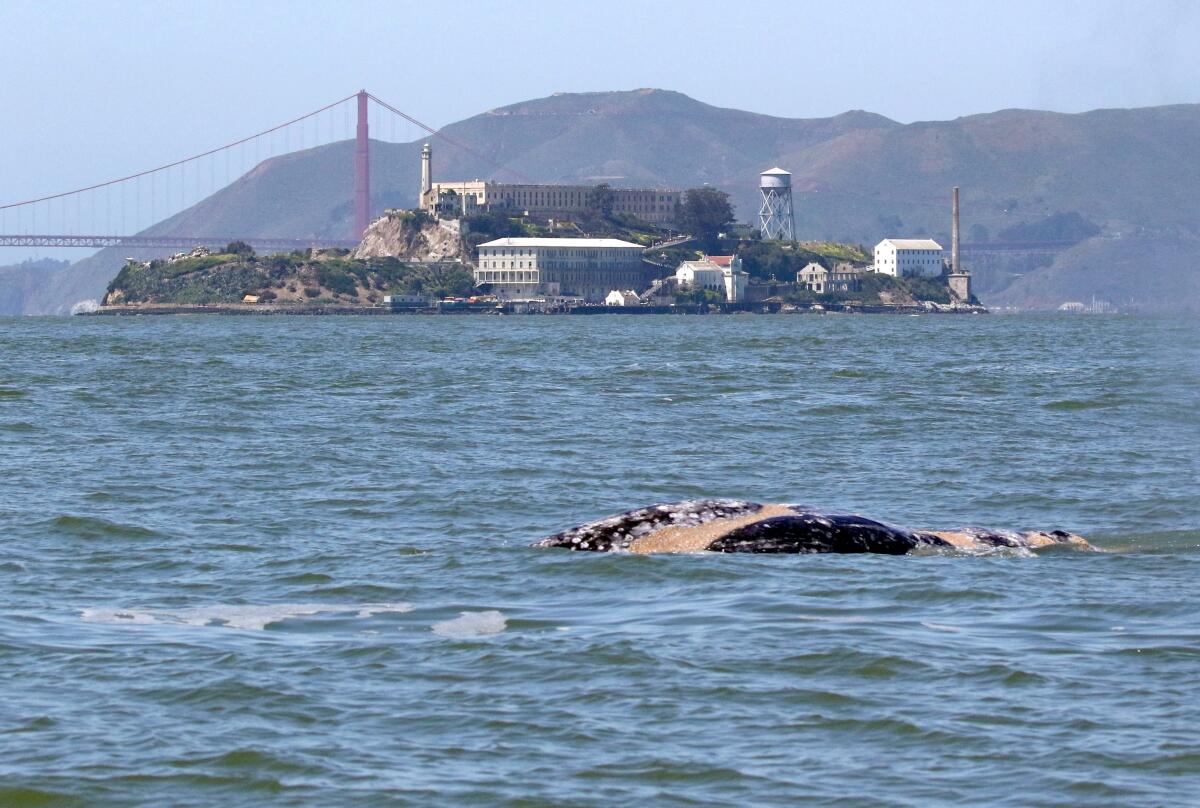Gray whale spends record amount of time in San Francisco Bay, concerning scientists

- Share via
A gray whale has been in the San Francisco Bay since early February, a record amount of time that could put the animal at risk of being struck by a ship, according to the Marine Mammal Center.
The whale, which arrived Feb. 9, was spotted Monday — 75 days later — by a research team on a boat, according to Bill Keener of the cetacean conservation biology team at the Marine Mammal Center, a nonprofit rescue organization. The previous record for a gray whale in the bay was 46 days.
“We can recognize the pigmentation patterns on whales. You can tell them apart if you look closely enough,” he said. “This whale has been here for 2½ months. That’s a record for us — we haven’t seen one stay that long before.”
During a normal year, the San Francisco Bay gets one or two gray whales that stay for a day or two, according to Keener. The whales breed in lagoons in Mexico and migrate to Alaska to feed, sometimes stopping in the bay along the way.
The waters in the San Francisco Bay are calm, and whales sometimes linger to eat and rest.
Beginning in 2019, more gray whales were seen stopping in the bay, and some washed up along the coast, prompting the National Oceanic and Atmospheric Administration to declare an “unusual mortality event.”
So far this migration season, eight gray whales and one humpback whale have been spotted in the bay, raising concerns among scientists who fear the animals could be struck by ships amid heavy maritime traffic between Oakland and San Francisco.
“We’ve got a complex story where whales are coming in the bay, which is a place of refuge for them, but that creates conservation concerns for us, with it being a busy port and the potential for ship strikes,” Kenner said. “That’s why we’re tracking all these whales in the bay and trying to keep them safe.”
A 35-foot gray washed up March 23 on Bolinas Beach, east of Duxbury Point, in Marin County — the first whale fatality in the region this year. Scientists with the Marine Mammal Center conducted a necropsy and concluded that the whale likely died of injuries after crashing into a boat.
Humpbacks began coming to the bay in 2016, as warming oceans resulted in less krill, the animals’ chief food source, which thrive in cold waters. Instead, the whales began coming closer to the coast to feed on anchovies.
“Over the decade, the bay has been really cleaned up,” Keener said. “I’ve seen no whales using the bay, and now we see humpbacks come in every year.”
Keener encouraged residents to report marine mammals they spot.
“We can’t always keep our eyes on the water,” he said, noting that reports from residents have been coming in. “It’s a big area.”
More to Read
Sign up for Essential California
The most important California stories and recommendations in your inbox every morning.
You may occasionally receive promotional content from the Los Angeles Times.











